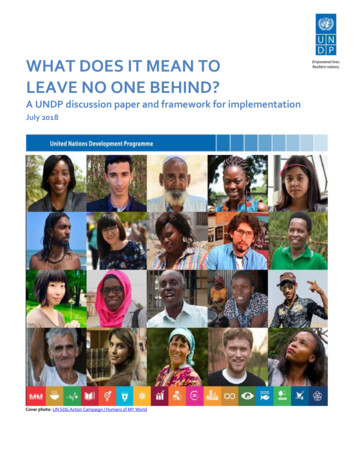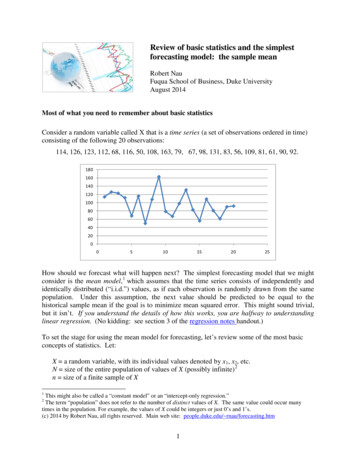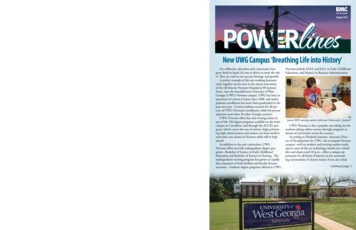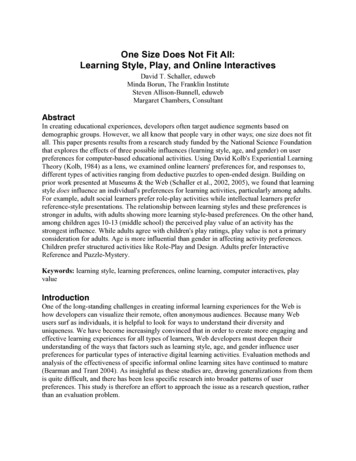
Transcription
WHAT DOES IT MEAN TOLEAVE NO ONE BEHIND?A UNDP discussion paper and framework for implementationJuly 2018WHAT DOES IT MEAN TOLEAVE NO ONE BEHIND?A UNDP discussion paper and framework for implementationJuly 2018Cover photo: UN SDG Action Campaign / Humans of MY World
TABLE OF CONTENTSTABLE OF CONTENTSExecutive SummaryPage 3I.IntroductionPage 6II.Who is being left behind and why: five key factorsPage 91. Discrimination2. Geography3. Governance4. Socio-economic status5. Shocks and fragilityIII.Understanding intersectionalityPage 18IV.Acting on the pledge to leave no one behindPage 21i. Examine: Understanding who is being left behind and whyii. Empower: Enabling voice and meaningful participationiii. Enact: Inclusive, catalytic and accountable strategies and financingV.Conclusion2WHAT DOES IT MEAN TO LEAVE NO ONE BEHIND?Page 28
Executive SummaryWith the adoption of the 2030 Agenda for Sustainable Development, 193 United Nations Member Statespledged to ensure “no one will be left behind” and to “endeavour to reach the furthest behind first.”1 Inpractice, this means taking explicit action to end extreme poverty, curb inequalities, confrontdiscrimination and fast-track progress for the furthest behind.This paper suggests a framework that governments and stakeholders can use in their countries to takeaction to leave no one behind in a way that enables and accelerates national progress to achieve theSustainable Development Goals (SDGs). It also seeks to inform the manner in which the UnitedNations Development Programme (UNDP) works with countries to implement the 2030 Agenda, inkeeping with the commitment of the United Nations Development System to put the pledge to leaveno one behind at the heart of its support.2Who is being left behind andwhy: Five key factorsPeople get left behind when they lackthe choices and opportunities toparticipate in and benefit fromdevelopment progress. All personsliving in extreme poverty can thus beconsidered ‘left behind’, as can thosewho endure disadvantages ordeprivations that limit their choicesand opportunities relative to others insociety.This paper asserts that to understandwho is being left behind and why, andto shape effective responses, five keyfactors should be assessed:1. Discrimination: What biases,exclusion or mistreatment do people face based on one or more aspect of their identity (ascribedor assumed), including prominently gender as well as ethnicity, age, class, disability, sexual1 “2030Agenda for Sustainable g/post2015/transformingourworld.2 The framework proposed here strives to be fully consistent with the UN Sustainable Development Group’s SDGOperational Guide on “leaving no one behind”, Guidelines for UN Development Assistance Frameworks, the UNChief Executive Board’s Framework on Inequalities and Non-Discrimination and UNDP Programming Standards.3WHAT DOES IT MEAN TO LEAVE NO ONE BEHIND?
orientation, religion, nationality, indigenous, migratory status etc.?2. Geography: Who endures isolation, vulnerability, missing or inferior public services,transportation, internet or other infrastructure gaps due to their place of residence?3. Governance: Where do people face disadvantage due to ineffective, unjust, unaccountable orunresponsive global, national and/or sub-national institutions? Who is affected by inequitable,inadequate or unjust laws, policies, processes or budgets? Who is less or unable to gaininfluence or participate meaningfully in the decisions that impact them?4. Socio-economic status: Who faces deprivation or disadvantages in terms of income, lifeexpectancy and educational attainment? Who has less chances to stay healthy, be nourished andeducated? Compete in the labour market? Acquire wealth and/or benefit from quality health care,clean water, sanitation, energy, social protection and financial services?5. Shocks and fragility: Who is more exposed and/or vulnerable to setbacks due to the impacts ofclimate change, natural hazards, violence, conflict, displacement, health emergencies, economicdownturns, price or other shocks?Realizing the opportunity to leave no one behindTo deliver on their commitment to realise the Agenda 2030, the paper suggests that countries take anintegrated approach, drawing on mutually reinforcing “levers” to examine, empower and enact change.Examine why people are left behind: To understand and address the drivers that leave people behind;countries must collect and use more and better disaggregated data and people-driven information. Theprogress of the furthest behind versus everyone else should tracked and reported for all relevant SDGs.UNDP can support countries to examine by: Undertaking integrated “leave no one behind assessments” using the framework offered here as astarting point for thinking, analysis and action; Strengthening national capacities to gather, analyze and use disaggregated data and evidence,including to understand the range of disadvantages and deprivations that leave people behind; Working with governments, national human rights institutions and civil society to institutionalizecommunity feedback mechanisms and collect people-centred data; Enabling the use of all available evidence to better understand and track the SDG progress of thefurthest behind and most vulnerable, relative to others; and Mobilizing all levels of government, marginalized communities, stakeholders and partners to fillgaps in disaggregated data with improved surveys and registries, new techniques and technologies,perception surveys, practitioner know-how, participatory mechanisms etc.Empower those who are left behind: To achieve the SDGs, the people that are being left behind must befull, equal agents of sustainable development. Urgent action is needed to enable and empower them,including by ensuring their meaningful participation in decision making and establishing safe andinclusive mechanisms for their civic engagement.4WHAT DOES IT MEAN TO LEAVE NO ONE BEHIND?
. can support countries to empower by:UNDP Facilitating a rights-based approach to programming that is conducive to meaningful participation,civic engagement and supporting the role of people, communities and civil society organizations toshape public decisions and hold government to account to realize their rights; Supporting governments to ensure SDG reporting, follow-up and review are people-centred,gender-sensitive, respect human rights and focus on the most vulnerable and furthest behind; Expanding opportunities for local civil society, national numan rights institutions and communitynetworks to engage decision makers, including to build consensus on the policies required toaddress gaps in SDG progress, taking into account state obligations and recommendations fromhuman rights treaty bodies and the Universal Periodic Review; Strengthening the capacities of civil society actors, and expanding and protecting spaces forpeople’s participation in political and public life; Building capacities of national and local authorities to be inclusive, responsive and accountable totheir populations, with a special focus on the furthest behind people and places; and Promoting and supporting women and young people’s political participation in parliamentary andelectoral processes as candidates and voters.Enact policies, laws, reforms, interventions to confront the drivers that leave people behind acrossSDGs: Duty-bearers and rights-holders will both need to shape, deliver and improve policies aimed atcurbing inequalities and upholding minimum standards of well-being.UNDP can support countries to enact by: Integrating the pledge to leave no one behind in SDG strategies, plans and budgets through equityfocused and rights-based approaches; Promoting equity-focused and rights-based laws, policies, public information campaigns andframeworks to address stigma and discrimination; Encouraging SDG localization to understand and address divergent rates of progress, establish SDGsupport mechanisms and capacities at central, regional and local levels; Building accountable, responsive and inclusive local governance systems to reduce inequalities andexclusion; Supporting governments and other stakeholders to identify, embed and report effectively on locallyachieveable and ambitious SDG targets essential to leave no one behind; Promoting, supporting and learning from policies and interventions to improve the opportunitiesand capabilities of the furthest behind people, groups and communities, and respectivegovernments; and Assessing options to finance leave no one behind policies and interventions .5WHAT DOES IT MEAN TO LEAVE NO ONE BEHIND?
I.IntroductionImpressive development gains over the last few decades have improved the lives of many millions.Despite population growth between 1990 and 2015, more than 1 billion people escaped extreme povertyand 2.6 billion gained access to an improved source of drinking water. Over the same period, the worldmade remarkable progress in lowering the mortality rate among children under five years old, reducingthe proportion of women who die in child-birth and tackling the human immunodeficiency virus (HIV),malaria and tuberculosis.3Hundreds of millions of people, however, were left behind, unable to fully participate in or benefitfrom human development, innovation, economic growth or globalization. They are overwhelminglyamong the world’s poorest and most marginalized people. Many endure disease, deprivations andindignities that have long been solved elsewhere. As a result, we continue to live in world in whichone person in nine is hungry, one in three is malnourished, around 800 million people struggle tosurvive on less than USD 1.90 a day and one in every three women experiences physical or sexualviolence in their lifetime.45As the poorest and most marginalized people slip further behind, inequalities have been pushed to newheights between and within countries. According to the 2018 World Inequality Report, income inequalitybetween people around the world has been rising since 1980, despite a period of unprecedented povertyreduction and growth. From 1980 to 2016, the world’s richest 1 percent captured twice as much of thegrowth in income worldwide, as the bottom 50 percent6. Over the last 25 years, the average (daily)income of the world’s poorest 20 percent grew by US 0.79; a significantly smaller margin than theaverage increase of US 8.91 for the other 80 percent.7 The world’s poorest countries have also becomerelatively poorer; while the spatial disparities between localities within countries grow wider.8Inequalities in terms of wealth and well-being continue to grow more extreme.9 In 2015, Oxfam foundthat 62 people controlled as much wealth as the poorer 50 percent of the world’s population. In 2017,3UNDP, “Human Development Report 2016: Human Development for Everyone,” p. 29. Available nt-report-2016-human-development-everyone4 World Health Organization (WHO) Department of Reproductive Health and Research, London School ofHygiene and Tropical Medicine, and South African Medical Research Council, “Global and Regional Estimatesof Violence Against Women,” 2013. Availablefrom /violence/9789241564625/en/.5 UNDP, “UNDP Human Development Report 2016: Human Development for Everyone.” Available fromhttp://hdr.undp.org/en/2016-report6 World Inequality Lab, “World Inequality Report 2018,” page 11. Available 8-full-report-english.pdf7Development Initiatives, P20 Baseline Report, 2017, p.30.Available from nitiative-baseline-report.pdf8 The proportion of the world’s poorest people in Least Developed Countries (LDCs) has more than doubledsince 1990. United Nations Conference on Trade and Development, “UNCTAD Least Developed CountriesReport 2016,” Geneva, Switzerland, 2016. Available riginalVersionID 3849 Wagstaff, A.; Bredenkamp. C and Buisman, L.R. “Progress on global health goals: Are the poor being leftbehind?” The World Bank Research Observer 29(2): p. 137-162, 2014.6WHAT DOES IT MEAN TO LEAVE NO ONE BEHIND?
they found that just 8 men controlled as much wealth as the bottom 50 percent.10 A study of 64 countriesbetween 1990 and 2011 found rising health inequalities in nearly half of those countries; while in aquarter, the health of the poorest 40 percent had actually regressed11.People are left behind when they lack the choices and capabilities that enable others to participate in orbenefit from human development. This can be due to their experience of: Absolute deprivation, where they live in multidimensional poverty or below other minimallyaccepted standards of security, income, public services, infastructure or well-being; and Relative disadvantage, where they face exclusion, discrimination and/or entrenched inequalities; areless able to gain influence, get an educated, survive setbacks, aquire wealth, access job markets ortechnologies; have shorter, riskier lives; rank below median in SDG outcomes and opportunities.Across countries, women and girls, people in rural areas, indigenous peoples, ethnic and linguisticminorities, people with disabilities, migrants, gender and sexual minorities, youth and older persons aredisproportionately among the left behind.12 In all societies, the furthest behind tend to endure multipleand intersecting disadvantages. With little social mobility and stark inequalities conspire to entrenchand perpetuate the disadvantages and deprivations that leave people behind, within and betweencountries. When people are unable to get ahead or gain influence and perceive “the system to berigged”, their aspirations shrink, along with the space for political solutions, social trust, meritocracy andproblem solving13.New agenda, new opportunitiesThe 2030 Agenda
With the adoption of the 2030 Agenda for Sustainable Development, 193 United Nations Member States pledged to ensure “no one will be left behind” and to “endeavour to reach the furthest behind first.”1 In practice, this means taking explicit action to end extreme poverty, curb inequalities, confront discrimination and fast-track progress for the furthest behind. This paper suggests a .











